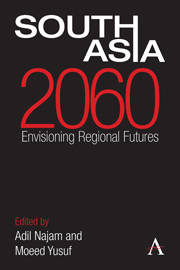Book contents
- Frontmatter
- Contents
- Acknowledgments
- List of Abbreviations
- Introduction: Imagining South Asian Futures
- Section I South Asia as a Region
- Section II State Relations
- Chapter 6 The Future of Democracy
- Chapter 7 Conflict and Reconciliation: Three Scenarios
- Chapter 8 Religion and State Formation
- Chapter 9 Will South Asia Still Be Terrorism's Center of Gravity?
- Chapter 10 Speculations on Nuclear South Asia
- Chapter 11 Nuclear Risk: Overstated or Underrated?
- Chapter 12 The Shadow of the India–Pakistan Stalemate
- Chapter 13 Regional Integration
- Chapter 14 The Future of Integration
- Chapter 15 The Giant Neighbor: Why is China Important?
- Section III Development
- Section IV Human Well-Being
- About the Authors
- Bibliography
- Index
Chapter 9 - Will South Asia Still Be Terrorism's Center of Gravity?
from Section II - State Relations
Published online by Cambridge University Press: 05 September 2013
- Frontmatter
- Contents
- Acknowledgments
- List of Abbreviations
- Introduction: Imagining South Asian Futures
- Section I South Asia as a Region
- Section II State Relations
- Chapter 6 The Future of Democracy
- Chapter 7 Conflict and Reconciliation: Three Scenarios
- Chapter 8 Religion and State Formation
- Chapter 9 Will South Asia Still Be Terrorism's Center of Gravity?
- Chapter 10 Speculations on Nuclear South Asia
- Chapter 11 Nuclear Risk: Overstated or Underrated?
- Chapter 12 The Shadow of the India–Pakistan Stalemate
- Chapter 13 Regional Integration
- Chapter 14 The Future of Integration
- Chapter 15 The Giant Neighbor: Why is China Important?
- Section III Development
- Section IV Human Well-Being
- About the Authors
- Bibliography
- Index
Summary
Terrorism, in this essay, equates with violence; it involves the use of violence to achieve what are essentially political goals. In this context, terrorism becomes almost synonymous with extremism from which springs the frequent sectarian violence that is also, sadly, a characteristic of most of South Asia, as well as the frequent social and gender violence. Terrorism is only one source then, though the major one, of the violence that is a constant factor and threat in the life of most South Asians.
Terrorist violence comes in many varieties in South Asia, and no country of the region but for the ministates of Bhutan and Maldives has escaped its ravages. In several of the region's countries it seems to emanate as much from exterior forces as from domestic ones. In others, its genesis is primarily from indigenous grievances and/or deficiencies of domestic governance. While it clearly is the product of distinct political and social toxicities in each of the various countries of the region, there are many common threads. The most important of these is its almost automatic resort to violence – often a preference for violence. This defines terrorism/extremism, no matter what the goals are.
- Type
- Chapter
- Information
- South Asia 2060Envisioning Regional Futures, pp. 75 - 81Publisher: Anthem PressPrint publication year: 2013

